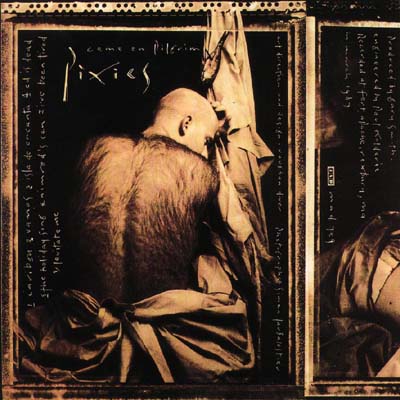Discography Odyssey: Pixies Part One, Come on Pilgrim/Purple Tape
By TheKidNixon 1 Comments
This is a series of blogs that I wrote/was writing about two years back on 1Up, before that community kinda went sideways with the whole we-just-fired-most-of-the-good-talent-we-had-left debacle. Have recently thought about doing it again, so here I am...doing it again, though starting with the already written entries so that I can prepare and write for the future ones. In short, this is a thrice weekly series of reviews/criticisms where I chronologically go through the discography of a popular band, offering my reflections on each of their albums. I started the whole thing with a series on one of the most influential bands of the back half of the 80s: Pixies.

The problem of course is that Pilgrim has a lot going for it, including songs that don't appear on Surfer Rosa and a more stripped down (thus enlightening) production than Surfer Rosa's alienating but enchanting sense of space. Thus, to only consider Pilgrim as the "the Surfer Rosa practice sessions" is horribly misguided and sells the album short.
The second half of this blog will center around what fans typically refer to as "the Purple Tape", which constitutes the rest of the material recorded during the Come On Pilgrim sessions but was considered not ready for wide release at the time. More on that later.
First and foremost, consider the earliest Pixies material released, Come On Pilgrim. The essential elements of the Pixies' sound are all there, especially early Pixies which can be termed as "Space Country": a sparse, noisy selection of songs that offer an off-kilter reflection of the singer-songwriter lexicon of the best of 50s and 60s country-western music. The twist comes into two places: the musicians have been weened on the adrenaline of punk rock, and the singer in question is possibly insane. Attempting to dissect (Frank) Black Francis' lyrics can lead to some seriously unsettling conclusions. It is odd for any band to have two songs dedicated to the subject of Biblical incest on one album ("Holiday Song" and "Nimrod's Son"), much less stack them directly on top of each other as if forcing the point.
Still, even more disturbing is how Black hardly ever obscures his subject matter lyrically, but rather gleefully seems to shriek them as twisted gospel, backed up appropriately enough by the angelic vocals of Kim Deal and her grooving bass lines. Cornered in by David Lovering's pounding drums and Joey Santiago's surrealistic guitar sounds, the band presents itself with as much energy and yearning as their contemporaries in a sound that seems completely left field. Structurally it is Country-Western gospel, but the tone of both the lead guitar and a loose drumming pattern makes it swim in trippy atmosphere and float away. There is very little production to get in the way of performance, offering a fairly close idea of what a Pixies live show at this point in their career would have sounded like. Overall, Come On Pilgrim serves as both a bold debut for a band with clearly a lot of ideas floating around, as well as a sampling of things to come in the near future. By the time the jangling "Levitate Me" finishes its childishly simple and nonsensical dark dance, Black and his co-conspirators have left those lucky enough to hear demanding more.
Interestingly enough, the Purple Tape material (eventually released official-like in the post-Fight Club resurgence of Pixies popularity under an eponymous title, despite circulating in bootleg circles for years) actually suggests a far deeper and wider set of influences than the material that appeared on Come on Pilgrim, yet none of it sounds nearly as exciting. Besides the early recording of "Broken Face" (which feels like it could belong on Pilgrim,) the rest of the throw away material feels like songs in the making, recorded in an embarrassing infancy. Nearly all will be fleshed out to perfection in their final variant, especially "Here Comes Your Man", which has all the pop sensibilities the final version will have but with an over emphasis on being too twangy and sweet rather than the desperate pleading it eventually earns. Still, the album is an interesting compare-and-contrast hodge-podge for later recordings, picking out certain riffs and ideas that appear in completely different songs than their original home. Also included is the live classic and David Lynch send-up "In Heaven", as well as "Rock A My Soul", the only thing coming close to a lost treasure as it was never given a full treatment, but rather scavenged for ideas in later releases.
